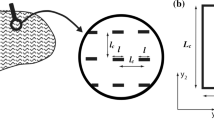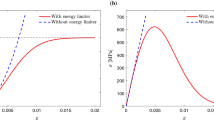Summary
Presented in this paper is a three-dimensional, micromechanical evolutionary damage model enabling the calculation of an overall constitutive relation of microcrack-weakened brittle materials under complex loading. An approximate scheme is proposed to determine the effects of microcrack interaction on the overall constitutive relation under complex loading. All microcracks are assumed to be embedded in an approximate effective medium that is weakened by uniformly distributed microcracks of the same radius depending upon the actual damage state. This elastic moduli of this approximate effective medium can be calculated by the well-established Taylor's model, self-consistent method, differential method, or other effective medium methods. The effective compliance tensor uncluding the influences of microcrack interaction is formulated for brittle solids under arbitrary tensile loading. This approximate method improves the accuracy of the Taylor model by implementing the effects of microcrack interaction in the overall constitutive relation and avoids the cumbersome computation of the self-consistent method in general loading cases.
Similar content being viewed by others
References
Krajcinovic, D.: Damage mechanics. Amsterdam: Elsevier 1997.
Krajcinovic, D.: Damage mechanics. Mech. Mater.8, 117–197 (1989).
Nemat-Nasser, S., Hori, M.: Micromechanics, overall properties of heterogeneous materials. Amsterdam: North-Holland 1993.
Kachanov, M.: Elastic solids with many cracks and related problems. In: Advances in applied mechanics, vol.30 (Hutchinson, J. W., Wu, T. W. eds.), pp. 259–428. New York: Academic Press 1993.
Budiansky, B., O'Connell, R. J.: Elastic moduli of a cracked solid. Int. J. Solids Struct12, 81–92 (1976).
Hori, H., Nemat-Nasser, S.: Overall moduli of solids with microcracks, load-induced anisotropy. J. Mech. Phys. Solids31, 155–171 (1983).
Mori, T., Tanaka, K.: Average stress in matrix and average elastic energy of materials with misfitting inclusions. Acta Metall21, 571–574 (1973).
Benveniste, Y.: On the Mori-Tanaka's method in cracked bodies. Mech. Res. Comm.13, 193–201 (1986).
Weng, G. J.: The theoretical connection between Mori-Tanaka's theory and the Hashin-Shtrikman-Walpole bounds. Int. J. Eng. Sci.28, 1111–1120 (1990).
Hashin, Z.: The differential scheme and its application to cracked materials. J. Mech. Phys. Solids36, 719–734 (1988).
Huang, Y., Hu, K. X., Chandra, A.: A generalized self-consistent mechanics method for microcracked solids. J. Mech. Phys. Solids42, 1273–1291 (1994).
Kunin, I. A.: Elastic media with microstructures, II. Berlin: Springer 1983.
Ju, J. W., Chen, T. M.: Effective moduli of two-dimensional brittle solids with interacting microcracks. J. Appl. Mech.61, 349–366 (1994).
Ju, J. W., Tseng, K. H.: A three-dimensional statistical micromechanical theory for brittle solids with interacting microcracks. Int. J. Damage Mech.1, 102–131 (1992).
Krajcinovic, D., Fanella, D.: A micromechanical damage model for concrete. Eng. Fract. Mech.25, 585–596 (1986).
Feng, X. Q., Yu, S. W.: Micromechanical modeling of tensile response of elastic-brittle materials. Int. J. Solids Struct.32, 3359–3374 (1995).
Yu, S. W., Feng, X. Q.: A micromechanics-based model for microcrack-weakened brittle solids. Mech. Mater20, 59–76 (1995).
Sumarac, D., Krajcinovic, D.: A self-consistent model for microcrack-weakened solids. Mech. Mater.6, 39–52 (1987).
Ju, J. W., Lee, X.: Micromchanical damage models for brittle materials. J. Eng. Mech. Div., ASCE117, 1495–1536 (1991).
Krajcinovic, D., Sumarac, D.: A mesomechanical model for brittle deformation processes. J. Appl. Mech.56, 51–62 (1989).
Fanella, D., Krajcinovic, D.: A micromechanical model for concrete in compression. Eng. Fract. Mech.29, 49–66 (1988).
Kanninen, M. F., Popelar, C. P.: Advanced fracture mechanics. London: Oxford University Press 1985.
Feng, X. Q., Gross, D.: Three-dimensional micromechanical model for quasi-brittle solids with residual strains under tension. Int. J. Damage Mech. (to appear).
Ortiz, M.: A constitutive theory for the inelastic behavior of concrete. Mech. Mater.4, 67–93 (1985).
Chow, C. L., Wang, J.: An isotropic theory of elasticity for continuum damage mechanics. Int. J. Fract.33, 3–16 (1987).
Zheng, Q. S., Collins, I. F.: The relationship between damage variables and their evolution laws and microstructural and physical properties. Proc. Royal Soc. LondonA454, 1469–1698 (1998).
Feng, X. Q.: Micromechanical damage theory of brittle materials and shakedown analysis of damaged structures. Doctoral Thesis. Tsinghua University, Beijing 1995.
Author information
Authors and Affiliations
Rights and permissions
About this article
Cite this article
Feng, X.Q., Gross, D. An approximate scheme for considering effects of microcrack interaction on the overall constitutive relation of brittle solids under complex loading. Acta Mechanica 139, 143–159 (2000). https://doi.org/10.1007/BF01170187
Received:
Issue Date:
DOI: https://doi.org/10.1007/BF01170187




